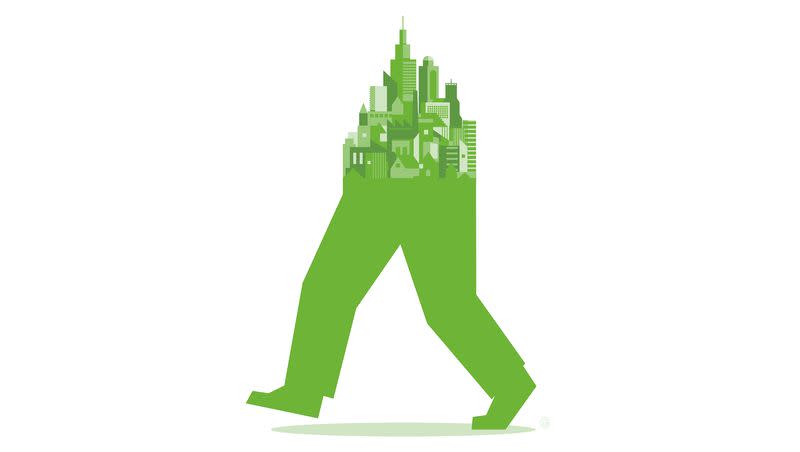Strolling into controversy

- Oops!Something went wrong.Please try again later.
The “15-minute city” could change the way we live. This urban planning concept, introduced in 2016 by Carlos Moreno, scientific director at Panthéon Sorbonne University-IAE in Paris, puts essential resources and daily destinations within a short walk or bike ride for each resident.
Cities from Barcelona, Spain, to O’Fallon, Illinois, have taken up the experiment to varying degrees, and proponents argue that it will reduce car emissions and increase quality of life. While the idea has quickly become fodder for conspiracy theorists, more reasonable critics are concerned with the social cost and administrative feasibility of rebuilding cities around pedestrians.
Not new, but has it improved?
The basic concept of the “15-minute city,” as a way to reduce pollution from cars and to increase quality of life, isn’t new. “I think you can look at most urban development that happened prewar, pre-mass expansion of personal automobile use, and you can see examples of that,” says urban designer Mallory Baches, director of strategic development at the nonprofit Congress for the New Urbanism.
But as more cities have started talking about it, it’s also spawned a backlash. In the U.K., Conservative politician Nick Fletcher called 15-minute cities an “international socialist concept” that would “take away your personal freedoms.” In reality, the idea offers more freedom, not less. “What it means is as an individual, you aren’t relegated to your automobile,” says Baches.
There are multiple benefits. Less time spent driving means more free time to do things you actually enjoy (in studies, people rank commuting as one of their least favorite activities, unsurprisingly). Walking reduces your risk of diabetes or heart disease and makes you happier. A study found that if you have an hour-long commute, you’d need to earn 40 percent more to be as happy as someone who can walk to work. The list goes on.
The concept isn’t just about a particular neighborhood: Fifteen-minute zones stretch farther than single neighborhoods and overlap, and if someone wants to go to another part of the city, they obviously can.
Still, people balk at the idea of changes in infrastructure that could make walking and biking easier. But people forget, Baches says, that top-down planning created that car dependency, including zoning that keeps housing far from stores, or wide streets with fast traffic and little shade that few people want to walk on. It’s not so much that people choose to drive, as they’ve been forced into it by bad design.
Adapted from “The Case for 15-Minute Cities” by Adele Peters, in Fast Company. Peters is a staff writer at Fast Company who previously worked in the Sustainable Products and Solutions program at UC Berkeley.
Utopia or dystopia?
Behold, the “15-minute city.” At the most recent C40 World Mayors Summit, it’s all people could talk about. But this utopian vision comes with downsides that deserve attention. For one, it turns out the best way to implement such a plan is to discourage cars because there is no better way to convince people to cycle or walk to work. European cities are doing this by pedestrianizing large areas, taking initial steps to ban certain types of vehicles, or imposing heavy tolls for driving in city centers.
To achieve a 15-minute city, public administrations must also push private companies to set up shop where their urban planning determines. And the further the state gets its hands into the private sector, the bigger the setback for the free market.
Carlos Moreno himself has pushed back on the more conspiratorial criticisms of his campaign, reportedly calling them “lies.” It is possible that Moreno is sincere, but it is also reasonable to assume that the politicians who must implement his plan would feel quite comfortable imposing restrictions on citizens, as they demonstrated in the pandemic. And call me paranoid, but I don’t trust that the technocrats devising these systems will resist the urge to go Big Brother. Like any utopia, the 15-minute city could only work by giving too much power to the government.
Even without any of that, turning cities into dozens of small, self-contained ecosystems would only worsen our epidemic of alienation and make us even more insular in our habits. Most of us hate driving in city traffic, but there is a societal value in having to hop in the car a couple times a week to go run an errand, or more often than that to go to work. Mingling with others in your city — or, gasp, outside of it — enriches you and increases your sense of belonging. It expands your world. And, besides, some of us just like to drive, to give full throttle before the stoplight closes and curse each other in traffic jams as a form of release.
Adapted from “The Problem with the ‘15-Minute City’ Utopia” by Itxu Díaz, in National Review. Diaz is a Spanish journalist, political satirist, and author who previously was an adviser to the Spanish Ministry for Education, Culture, and Sports.
This story appears in the May issue of Deseret Magazine. Learn more about how to subscribe.

